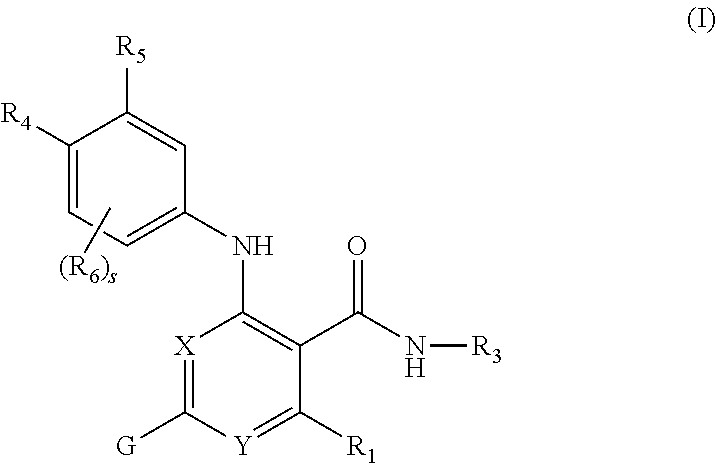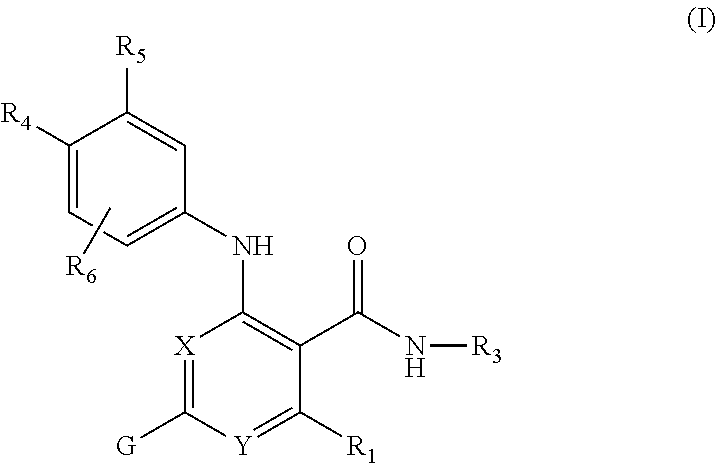Nicotinamide compounds useful as kinase modulators
a technology of nicotinamide and kinase, applied in the direction of biocide, drug composition, immunological disorders, etc., can solve the problem of marked improvement of disease progression
- Summary
- Abstract
- Description
- Claims
- Application Information
AI Technical Summary
Benefits of technology
Problems solved by technology
Method used
Image
Examples
example 1
(R)-tert-Butyl 1-(5-carbamoyl-6-(4-(morpholine-4-carbonyl)phenylamino)pyridin-2-yl)piperidin-3-ylcarbamate
[0460]
A. 6-Chloro-2-(4-(morpholine-4-carbonyl)phenylamino)nicotinic acid
[0461]
[0462]To a suspension of (4-aminophenyl)(morpholino)methanone (9.02 g, 43.8 mmol) in THF (20 mL) was added lithium bis(trimethylsilyl)amide (66.7 mL, 66.7 mmol, 1M solution in THF) dropwise over 15 min. at −78° C. under nitrogen. The reaction mixture was stirred for one hour at −78° C. To the resulting brown solution was added a solution of 2,6-dichloronicotinic acid (4 g, 20.83 mmol) in THF (12 ml) dropwise at −78° C. The reaction mixture was removed from the dry ice bath and stirred overnight at rt. The resulting dark solids were washed with a small amount of THF to remove (4-aminophenyl)(morpholino)methanone on the surface, followed by the addition of water and 18 ml of 6N HCl (pH of 2). The solids were filtered and the resulting pink filter cake was washed with water (˜1 L) until the filter cake wa...
example 2
(R)-6-(3-Aminopiperidin-1-yl)-2-(4-(morpholine-4-carbonyl)phenylamino)nicotinamide
[0470]
[0471]A solution of (R)-tert-butyl 1-(5-carbamoyl-6-(4-(morpholine-4-carbonyl)phenylamino)pyridin-2-yl)piperidin-3-ylcarbamate (1.7 g) in CH2Cl2 (3 ml) was treated with 3 ml of TFA and stirred at rt for 2 h. The reaction mixture was concentrated, basified with 1N NaOH, and extracted three times with CH2Cl2. The resulting organic layer was concentrated to obtained 1.367 g of (R)-6-(3-aminopiperidin-1-yl)-2-(4-(morpholine-4-carbonyl)phenylamino)nicotinamide as a pale yellow solid. LCMS: (M+H)+=425.08. 1H NMR (400 MHz, CDCl3) δ ppm 11.21 (1H, s), 7.71 (2H, d, J=8.56 Hz), 7.52 (1H, d, J=8.81 Hz), 7.38 (2H, d, J=8.56 Hz), 6.06 (1H, d, J=8.80 Hz), 5.62 (2H, s), 4.19 (1H, d, J=9.57 Hz), 4.06-4.14 (1H, m, J=13.35 Hz), 3.59-3.79 (8H, m), 3.03-3.13 (1H, m), 2.78-2.92 (2H, m), 1.95-2.06 (1H, m), 1.73-1.86 (1H, m), 1.51-1.64 (1H, m), 1.30-1.46 (1H, m).
example 3
(R)-6-(3-Benzamidopiperidin-1-yl)-2-(4-(morpholine-4-carbonyl)phenylamino)nicotinamide
[0472]
[0473]To a solution of (R)-6-(3-aminopiperidin-1-yl)-2-(4-(morpholine-4-carbonyl)phenylamino)nicotinamide (27.5 mg, 0.065 mmol) and Et3N (0.014 mL, 0.097 mmol) in THF (2 mL) was added benzoyl chloride (10.93 mg, 0.078 mmol). The reaction mixture was stirred at rt for 10 min, quenched with satd. NaHCO3, extracted twice with CH2Cl2, separated, and concentrated. The residue was purified by ISCO (100% ethyl acetate, 12 g column) to obtain 24 mg of (R)-6-(3-benzamidopiperidin-1-yl)-2-(4-(morpholine-4-carbonyl)phenylamino)nicotinamide as a white solid. LCMS: (M+H)+=529.38. 1H NMR (400 MHz, CDCl3) δ ppm 11.22 (1H, s), 7.66 (2H, d, J=8.56 Hz), 7.59-7.64 (2H, m), 7.53 (1H, d, J=9.06 Hz), 7.42-7.49 (1H, m), 7.37 (1H, d, J=7.81 Hz), 7.31 (1H, d, J=8.56 Hz), 6.55 (1H, d, J=6.80 Hz), 6.11-6.18 (1H, m), 5.60 (2H, s), 4.17-4.28 (1H, m), 3.86-3.94 (1H, m), 3.53-3.83 (11H, m), 1.96-2.06 (1H, m), 1.88-1.95 (1H...
PUM
| Property | Measurement | Unit |
|---|---|---|
| volume | aaaaa | aaaaa |
| total volume | aaaaa | aaaaa |
| temperature | aaaaa | aaaaa |
Abstract
Description
Claims
Application Information
 Login to View More
Login to View More - R&D
- Intellectual Property
- Life Sciences
- Materials
- Tech Scout
- Unparalleled Data Quality
- Higher Quality Content
- 60% Fewer Hallucinations
Browse by: Latest US Patents, China's latest patents, Technical Efficacy Thesaurus, Application Domain, Technology Topic, Popular Technical Reports.
© 2025 PatSnap. All rights reserved.Legal|Privacy policy|Modern Slavery Act Transparency Statement|Sitemap|About US| Contact US: help@patsnap.com



